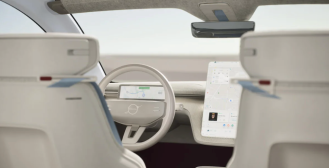Volvo plans to use Epic Games’ Unreal Engine to bring photorealistic displays to its next generation of electric vehicles. The Swedish automaker said that one key goal of its new system is to find “clever ways” to show drivers visualizations of their surroundings on the road.
The challenge: Modern cars pack a lot of computing power, with a single vehicle packing as many as 50 different computer systems that can operate more than 100 million lines of code.
Some of that computing power goes toward safety features, such as lane-assistance when you drift over the road line, adaptive cruise control, and automatic brake warnings.
External sensors capture information about the driver’s surroundings and relay that information through so-called human-machine interfaces (HMIs) — the technology that communicates between the driver and car, such as a head unit or head-up display, or even the steering wheel and gas pedal.
The sensors that cars use to collect data on the environment — cameras, radar, lidar — are getting increasingly sophisticated. The hard part is presenting useful information to drivers without distracting them with too much data, or with unwanted visuals like glare and occlusion.
The solution: Volvo is betting that Unreal Engine can enable its new HMIs to hit the sweet spot between too little and too much visual information, all while rendering visuals quickly and in high definition.
Unreal Engine is a free-to-use suite of tools that developers use to create incredible 3D computer graphics. First introduced in 1998, Epic Games’ newest version of the tool — Unreal Engine 5 — released earlier this year and can produce stunningly photorealistic graphics for video games and animations.
Gaming engines in cars: Why would a car need such a high-powered graphics engine? One reason is speed. Volvo said its new HMIs will be able to generate and process graphics up to 10 times faster than earlier systems.
“The responsiveness of these systems is very important,” Thomas Stovicek, head of user experience at Volvo Cars, said in a video.
“The quicker the system can give the user the information, the quicker they can respond—whether it’s to address another car coming in from the side or something else in the road.”
While it’s a safe bet that Unreal Engine will enable greater processing speeds, it’s unclear how the HMIs will display visual information to drivers.
But one clue comes from Rivian, whose electric truck features displays powered by Unreal Engine.
The truck’s head-up display provides drivers with an overhead view of their car, which is presented against a minimalistic rendering of the road. Similar to the head-up displays in Teslas, the renderings also show drivers where their car is in relation to traffic lines and nearby vehicles.
The extent to which Volvo’s next-generation HMIs could improve driver safety remains unclear. But Volvo has long been an innovator in car safety. The Swedish automaker was the first to introduce the three-point seatbelt in 1959, the rear-facing child seat in 1972, and side-impact and curtain airbags in the 1990s.
We’d love to hear from you! If you have a comment about this article or if you have a tip for a future Freethink story, please email us at [email protected].





